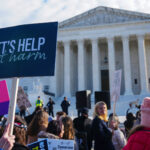Why is the issue of pornography as a public health crisis in the news?
On April 19 Utah became the first state to pass a nonbinding resolution declaring pornography a “public health hazard.”
This concurrent resolution of the Utah legislature and the governor—which passed without a single dissenting vote—contains 18 statements, including the recognition that “pornography is a public health hazard leading to a broad spectrum of individual and public health impacts and societal harms.”
.jpg)
What is the “pornography as public health crisis” movement?
Although pornography has been identified as a public health concern for more than three decades (see below), the increase in access and the ubiquity of pornography has increased concerns about the effects of pornography on communities.
Public health is defined as the “art and science dealing with the protection and improvement of community health by organized community effort and including preventive medicine and sanitary and social science.” The Center for Disease Control identifies four elements of a public health model as: (1) Define and monitor the problem, (2) Identify risk and protective factors, (3) Develop and test prevention strategies, and (4) Assure widespread adoption (dissemination and implementation).
The pornography as public health crisis (hereafter abbreviated as PPHC) movement adopts this model to address the negative effects of pornography on public health. As Cordelia Anderson explains,
An important aspect of a public health perspective is adding resources to problems that affect individuals or groups beyond their capacity to correct them. In a public health approach, the responsibility shifts from that of individuals alone to the public as a whole, to address the external social causes or influences and hold them accountable for their impact on individuals and society (Wallack, 1989).
Who is behind the “pornography as public health crisis” movement?
The PPHC movement includes a broad and diverse range of individuals, groups, and organizations concerned about the affects of pornography on public health. The concerns are shared by a loose coalition of parent groups, secular feminist activists, social science researchers, evangelicals, Catholics, Mormons, and so on. While there may be a consensus on the problem, there is some general disagreement about the proposed solutions (e.g., promotion of “comprehensive sex-education”).
When did pornography become a public health concern?
From the late 1960s to the mid-1980s, several commissions funded by the federal government to examine the issue of pornography concluded it had “no marked social effect.” However, the United States Attorney General’s Commission on Pornography was formed in 1985 to address a number of concerns:
(a) continuing criticism of the findings of previous commissions;
(b) recent technological advances and changes in social standards that had allowed both youth and adults easier access to pornography;
(c) recent research indicating that the content of both “hardcore” and traditional “softcore” pornography had changed in the 1970s and 1980s to include considerably more sexually violent material; and
(d) preliminary research suggesting that these new forms of pornography had different effects on viewers’ attitudes and behaviors than the pornography studied earlier.
U.S. Surgeon General C. Everett Koop was asked to testify before the commission, and in preparation convened the Surgeon General’s Workshop on Pornography. The workshop participants reached “some consensus regarding the effects of pornography on the public health of citizens, especially children and adolescents.” Their consensus statements were:
• Children and adolescents who participate in the production of pornography experience adverse, enduring effects.
• Prolonged use of pornography increases belief that less common sexual practices are more common.
• Pornography that portrays sexual aggression as pleasurable for the victim increases the acceptance of the use of coercion in sexual relations.
• Acceptance of coercive sexuality appears to be related to sexual aggression.
• In laboratory studies measuring short-term effects, exposure to violent pornography increases punitive behavior toward women.
In the conclusion to their consensus statements, the participants said, “Pornography does have effects; it is just not yet known how widespread or powerful they really are.” They added, “Currently we have bits of knowledge about the effects of pornography; future research is required to unite these bits into a more comprehensive statement.”
What have we learned about pornography as a public health crisis since the 1980s?
Since the late 1980s an abundance of social science research has confirmed that pornography has a negative effect on individuals, families, children, and communities. While no social science research is ever completely conclusive (much less universally persuasive), most individuals who do not have a vested interest in denying the cumulative findings of the science (e.g., those who aren’t themselves consumers of pornography or apologists for the porn industry) are likely to find the evidence convincing.
For example, meta-analysis of 22 studies conducted between 1978 and 2014 from seven different countries found that “consumption was associated with sexual aggression in the United States and internationally, among males and females, and in cross-sectional and longitudinal studies” and that the “general pattern of results suggested that violent content may be an exacerbating factor.”
Another meta-analysis from 2010 found “an overall significant positive association between pornography use and attitudes supporting violence against women in nonexperimental studies.”
Additionally, pornography has been shown to have a significant effect on the brain.
What should Christians think about the “pornography as public health crisis” movement?
The PPHC movement should be viewed as a welcome approach to our fight against pornography.
Addressing the issue of pornography from a public health perspective does not replace the pastoral and familial actions that need to be taken, nor does it deny the moral responsibility of individuals. But it provides an additional means for us to deal with this public scourge in a broader manner that does not solely rely on faith-based arguments (while those are necessary, they are rarely sufficiently persuasive in the public square).
This approach also acknowledges what should be obvious to all rational citizens: pornography undeniably has a negative effect on the health of our communities. Acknowledging this fact allows us to work together with like-minded cobelligerents to find public solutions to this public problem. Christian involvement is also necessary to ensure that the proposed solutions are consistent with increasing human flourishing and do not produce results that are as harmful as the disease we are trying to eliminate.
“The Most Practical and Engaging Book on Christian Living Apart from the Bible”
 “If you’re going to read just one book on Christian living and how the gospel can be applied in your life, let this be your book.”—Elisa dos Santos, Amazon reviewer.
“If you’re going to read just one book on Christian living and how the gospel can be applied in your life, let this be your book.”—Elisa dos Santos, Amazon reviewer.
In this book, seasoned church planter Jeff Vanderstelt argues that you need to become “gospel fluent”—to think about your life through the truth of the gospel and rehearse it to yourself and others.
We’re delighted to offer the Gospel Fluency: Speaking the Truths of Jesus into the Everyday Stuff of Life ebook (Crossway) to you for FREE today. Click this link to get instant access to a resource that will help you apply the gospel more confidently to every area of your life.


































